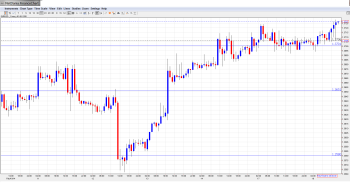EUR/USD is steady in Tuesday trading, as the pair trades above the 1.37 line in the European session. The first releases of the week were dismal, as Eurozone and German ZEW Economic Sentiment faltered badly in January and were well off the estimates. Eurozone Current Account continues to impress, beating the estimate for a third straight time. It’s a quiet day in the US, with no major events on the schedule. Today’s highlight is the Empire State Manufacturing Index, with the markets expecting a smaller gain than in the previous release.
Here is a quick update on the technical situation, indicators, and market sentiment that moves euro/dollar.
EUR/USD Technical
- It’s a case of more of the same for EUR/USD, with the pair sticking close to the 1.37 line in the Asian and European sessions.
Current range: 1.37 to 1.38
Further levels in both directions: 
- Below: 1.3650, 1.3580, 1.3515, 1.3450, 1.34, 1.3320, 1.3295, 1.3175, 1.31 and 1.3050.
- Above: 1.37, 1.38, 13915 and 1.40.
- 1.37 is back in a support role. 1.3650 is stronger.
- 1.38 is the next line of resistance.
EUR/USD Fundamentals
- 9:00 Eurozone Current Account. Exp. 19.8B, Actual 21.3B.
- 9:00 Italian Trade Balance. Exp. 2.79B, Actual 3.62B.
- 10:00 German ZEW Economic Sentiment. Exp. 61.3, Actual 55.7 points. See how to trade this event with EUR/USD.
- 10:00 Eurozone ZEW Economic Sentiment. Exp. 73.9, Actual 68.5 points.
- All Day ECOFIN Meetings.
- 13:30 US Empire State Manufacturing Index. Exp. 9.9 points.
- 14:00 US TIC Long-Term Purchases. Exp. 28.9B.
- 15:00 US NAHB Housing Market Index. Exp. 56 points.
*All times are GMT
For more events and lines, see the Euro to dollar forecast.
EUR/USD Sentiment
- Economic Sentiment falters: German ZEW Economic Sentiment slid to a three-month low, dropping to 55.7 points in January, compared to 61.7 a month earlier. The estimate stood at 61.3. The Eurozone reading followed suit, dropping from 73.3 to 68.5 points, way off the estimate of 73.9. Although these levels are relatively high, the fact that institutional investors and analysts are less optimistic is a reason for concern, and a slowing down of the German locomotive is the last thing the troubled Eurozone needs.
- Eurozone growth beats expectations: Figures from both core countries and especially from Germany beat analysts’ expectations. While the EZ recovery still looks fragile, the German strength seems to lead the Eurozone forward, and France isn’t pulling it back anymore. The fragility of the recovery looks weaker.
- ECB official hints at negative rates: The head of the Eurogroup, Dutch finance minister Joeren Dijsselbloem, said that that some say the value is too strong. His words join an ECB member that stated that the central bank is considering negative rates very seriously. These words weighed on the euro, which has since recovered. In addition, the Bank’s monthly bulletin cut inflation forecasts from 1.5% to 1.1% in 2014. ECB President Draghi seemed confident that things will sort themselves out, but another fall in inflation could still trigger a move in March.
- Greek debt relief discussion to be postponed: The Eurogroup is expected to decide on sending the troika delegation to Greece once again, to try and resolve the financing gap. However, a decision about new debt relief will await for late April. In the meantime, Greek PM Samaras stated that his country reached a primary surplus (balance without debt payments) of 1.5 billion euros in 2013. The Eurogroup meeting might result in quite a few headlines.
- Merkel coalition tensions: The third government of Angela Merkel is only two months old, and it is already under strain. A scandal that involves both Merkel’s CDU/CSU and the SPD partner might reach the SPD leader Sigmar Gabriel and weigh on the coalition. So far, the agriculture minister from her party resigned and he may have been scapegoated in order to save the coalition. Merkel will meet coalition leaders on Tuesday to calm the situation.
- Weak US data raises concerns: Retail sales fell in both January and December, lowering growth forecasts for both quarters. Bad weather was easily blamed, but perhaps the effect of the weather not that temporary (another storm hits the US) and perhaps the weakness is not only weather related. Meanwhile, the hiccups continue on the employment front, as Unemployment Claims were higher than expected last week. Convincing US figures are still missing.
More: Analysis: ECB expects the situation to sort itself out, but things could still worsen
